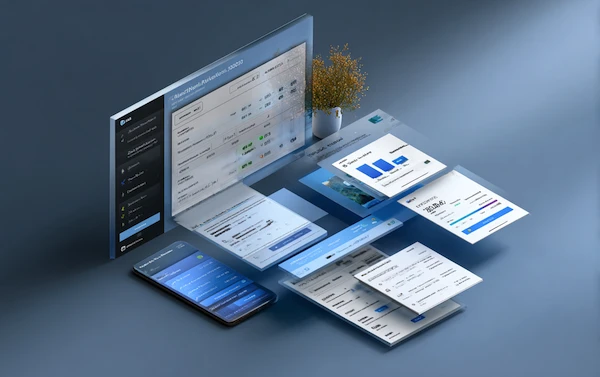Coming Up
What is Manual Reconciliation?
Manual reconciliation is the process of comparing two sets of financial records—such as internal ledgers and external statements—to identify and rectify discrepancies. This process is typically conducted using spreadsheets or accounting software, requiring meticulous attention to detail.
Key Steps in Manual Reconciliation
- Data Collection: Gather internal records (e.g., general ledger entries) and external documents (e.g., bank statements).
- Comparison: Match transactions between the two sets of records to identify inconsistencies.
- Investigation: Analyze discrepancies to determine their causes, such as timing differences or errors.
- Adjustment: Make necessary corrections to align the records.
- Documentation: Record the reconciliation process for audit trails and future reference.
Why is Manual Reconciliation Important?
Manual reconciliation plays a critical role in ensuring the accuracy and reliability of financial information.
Ensuring Financial Accuracy
Regular reconciliation helps detect errors or omissions in financial records, ensuring that financial statements reflect true financial positions.
Fraud Detection
By identifying unauthorized transactions or anomalies, manual reconciliation serves as a tool for fraud prevention and detection.
Regulatory Compliance
Maintaining accurate financial records through reconciliation is essential for complying with accounting standards and regulatory requirements.
What are the Benefits of Manual Reconciliation?
While manual reconciliation can be labor-intensive, it offers several benefits:
- Detailed Oversight: Provides a thorough understanding of financial transactions.
- Customization: Allows for tailored approaches to complex reconciliation scenarios.
- Immediate Control: Enables immediate intervention when discrepancies are found.
However, these benefits come at a cost, which is why companies are increasingly looking toward platforms like Solvexia to reduce manual workloads while maintaining control and transparency.
What are the Challenges of Manual Reconciliation?
Despite its benefits, manual reconciliation presents several challenges:
- Time-Consuming: The process can be slow, especially with large volumes of transactions.
- Error-Prone: Human errors in data entry or analysis can lead to inaccuracies.
- Resource Intensive: Requires significant manpower and expertise.
- Lack of Real-Time Insights: Delayed reconciliation can hinder timely decision-making.
By automating reconciliation workflows, Solvexia empowers teams to overcome these challenges and redirect focus to more strategic finance functions.
What are the Types of Manual Reconciliation?
Manual reconciliation can be applied to various financial areas:
- Bank Reconciliation: Matching internal cash records with bank statements.
- Accounts Receivable Reconciliation: Ensuring customer payments align with invoices.
- Accounts Payable Reconciliation: Verifying that outgoing payments match supplier invoices.
- Inventory Reconciliation: Aligning physical inventory counts with recorded amounts.
- Intercompany Reconciliation: Balancing transactions between different entities within the same organization.
How Does Manual Reconciliation Work?
The manual reconciliation process involves several steps:
- Preparation: Collect all relevant financial documents and records.
- Matching: Compare transactions across records to identify matches and discrepancies.
- Analysis: Investigate unmatched items to determine causes.
- Correction: Adjust records to resolve discrepancies.
- Review: Have reconciliations reviewed and approved by appropriate personnel.
- Documentation: Maintain records of the reconciliation process for accountability and audits.
What are Best Practices for Manual Reconciliation?
To enhance the effectiveness of manual reconciliation:
- Regular Scheduling: Perform reconciliations at consistent intervals (e.g., monthly).
- Standardized Procedures: Develop and adhere to standardized reconciliation processes.
- Training: Ensure staff are well-trained in reconciliation techniques and tools.
- Use of Templates: Utilize reconciliation templates to maintain consistency.
- Segregation of Duties: Separate responsibilities to reduce the risk of errors or fraud.
That said, adopting a reconciliation automation solution can help embed these best practices into your operations via automation.
How to Get Started with Manual Reconciliation?
Starting manual reconciliation involves:
- Identifying Accounts: Determine which accounts require reconciliation.
- Gathering Data: Collect all necessary financial records and statements.
- Setting Up Tools: Prepare spreadsheets or software for recording reconciliation activities.
- Assigning Roles: Designate personnel responsible for each step of the process.
- Establishing Timelines: Set deadlines for completing reconciliations.
How Solvexia Helps with Manual Reconciliation
While manual reconciliation has its place, automation can significantly enhance efficiency and accuracy. Solvexia offers automation solutions that streamline the reconciliation process, reducing manual effort and minimizing errors. By integrating financial automation tools, organizations can achieve faster reconciliations and more reliable financial reporting.
.svg)





























